All last week Miss Felicity was helping me with my sewing: making a 1913 skirt for the HSF Paisley & Plaid challenge.
We finished it last week Saturday, but my blouse wasn’t done and I couldn’t schedule time for a photoshoot. I took some quick documentary shots on Isabella:
For the Paisley & Plaid challenge I’d wanted to use an amazing paisley silk jacquard that I found at Fabric-a-brac a few months back, but I just couldn’t get my ideas to come together into the perfect design, and none of my wilder plaids were speaking to me either.
Then, a few weeks before the challenge, I found an amazing paisley twill at The Fabric Warehouse in Wellington. I loved the scattered woodblock inspired design, rather than the more common crowded, swirling Victorian paisley, and while orange isn’t usually a colour I gravitate towards, the dark blood-orange shade is really growing on me.
For the pattern I used the little diagram of the ‘Side fastening skirt’ from Thornton’s International System, 1913 which is reproduced in Janet Arnold’s Patterns of Fashion.
You can follow most of the construction along with Felicity’s help, but basically I drafted the pattern onto calico/muslin, made a toile, made some minor adjustments based on that, and then sewed the skirt up.
To break up the pattern and provide definition to the asymmetrical drape, I finished the edges with a silent piping made out of a wool cavalry twill I inherited from Nana. It’s the only piece of beige-y/brown fabric I have in my entire stash! The buttons are vintage tortoiseshell and mother of pearl buttons inherited from Grandma. I was really excited to find the perfect garment to showcase them on.
I did make a few changes from the pattern, as I only had a metre and a half of fabric to work with, so I omitted some of the overlap, and also managed not to notice that it is a ‘side fastening skirt’ and so mine fastens in back! (which is a real pain to hook up)
I finally had everything finished (and time for a photoshoot) this Friday. I tempted a friend who had the day free to help with photos in exchange for treats, and we explored the vicinity of Made on Marion for vintage-y locales.
I can’t decide if my favourite images are the ones taken against a blank black wall:
Or the ones taken in front of The Bake House, which would have been a brand new building when my skirt was en vogue:
The Bake House images do a great job of showing off the very clever patterning, with no side seams and the cunning addition of an angled back seam, which gives the skirt enough room for you to walk in, while keeping the front silhouette quite straight and slim.
My hat, if you are wondering, is a terrible last minute job where I bobby pinned a vintage feather to a reproduction ’30s hat for a quick and dirty 1910s look. I’m going to have to do a much better job next time!
After getting me thoroughly chilled in the brisk wind and slight drizzle (despite it being a very warm day for winter) we headed indoors to warm up with the promised treats at Floriditas, which serves tea in beautiful porcelain cups, and has the best cinnamon buns in New Zealand.
Floridita’s also has one other perk that made it just perfect for the event: paisley wallpaper!
By the way, have you noticed my blouse? Isn’t it pretty? Have you also noticed that it is very subtly checked? Oh yes! Paisley and plaid in one outfit! More about the blouse tomorrow…
The Challenge: #14 — Paisley & Plaid
Fabric: 1.5m of midweight paisley patterned cotton with a very fine twill weave ($18pm), scraps of wool cavalry twill (inherited).
Pattern: ‘Side fastening skirt’ from Thornton’s International System, 1913, reproduced in Janet Arnold’s Patterns of Fashion (only without a 22″ waist!).
Year: 1913, fashionable from about 1911-1915
Notions: Cotton thread, vintage tortoiseshell and mother of pearl buttons, buttonhole twist, bias tape (lots!), 13 hooks.
How historically accurate is it? Plausible as an avant garde designer item, but certainly not common or proven. The colour and small scattered prints were both extremely fashionable among the more exotic designers (such as Poiret), and there was a slight paisley revival in the 1910s, though all three elements were far more likely to be seen on soft, draping indoor and evening fabrics, not stiffer outdoor/suit costume fabrics. I had to alter the pattern slightly due to fabric constraints. Construction methods are spot on. So 85% at the best, and possibly not at all.
Hours to complete: 7ish, from drafting the pattern to the last hook and eye.
First worn: On Monday, to give my lectures at the local university (and no one noticed it was ‘period’) and then on Friday for the photoshoot.
Total Cost: $27 in fabric, less than $3 in trims = just under $30.

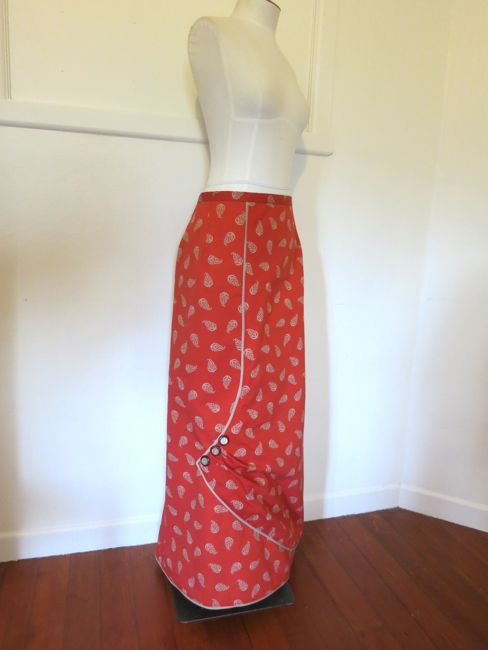



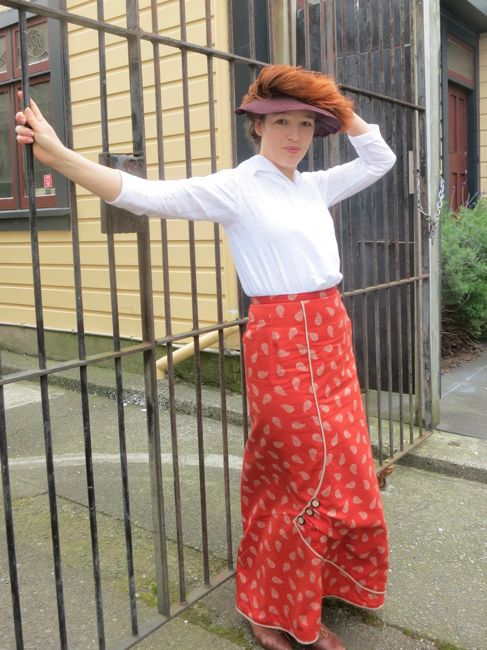
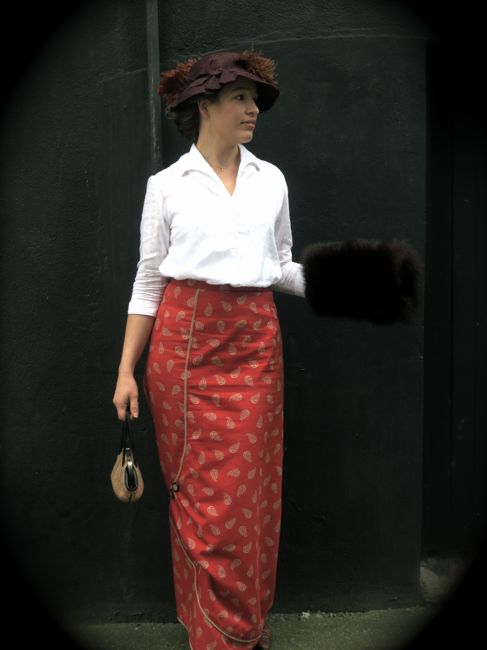
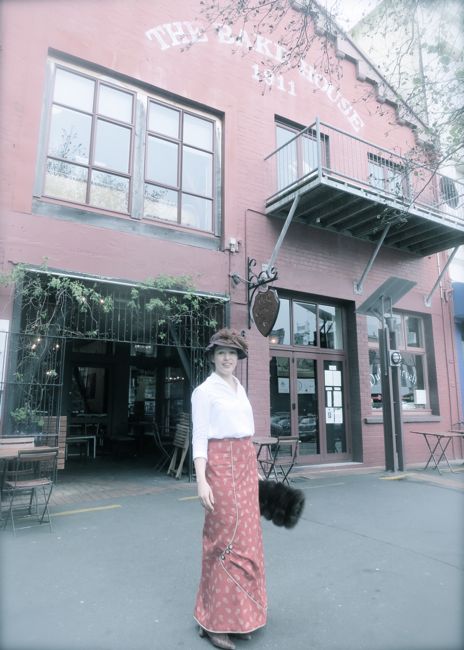

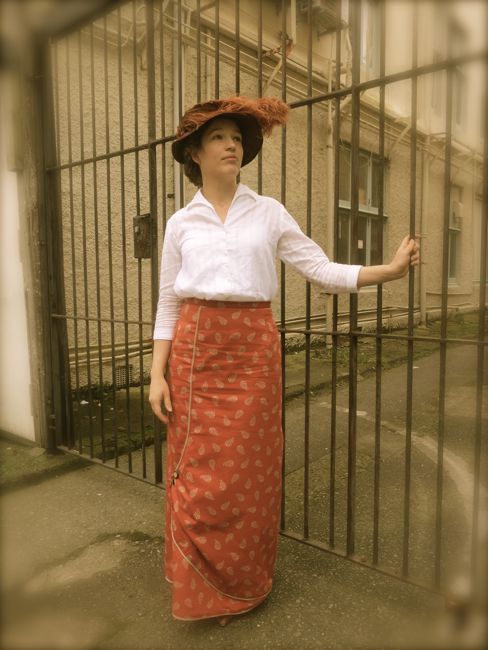
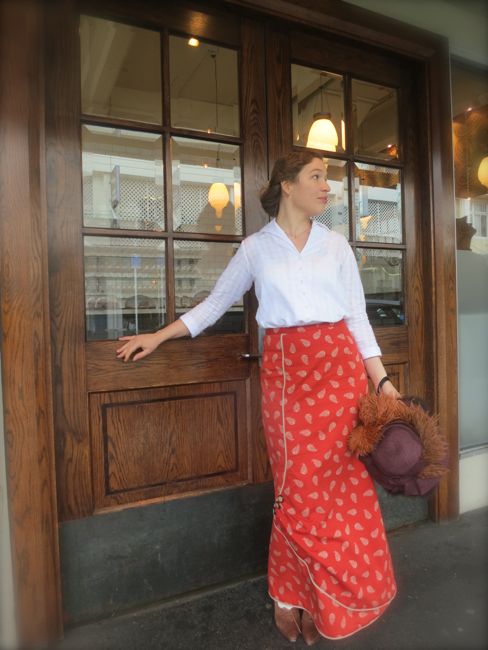

Very lovely skirt! I’m so bummed because I thought of the perfect project for this challenge using some plaid fabric in my stash just last night as I was trying to fall asleep. Definitely not getting done for this challenge but I’ll put it on my list.
Thank you! It is really annoying when you think of the perfect thing too late to do it. There is always Challenge #21: Re-Do for your skirt!
Just lovely!!
The construction is so interesting. One of my favourite things about the early 20th century is all the new shapes and cuts that designers were experimenting with. It’s so cool to see this skirt made up.
I would wear this skirt anywhere, anytime. Love everything about it.